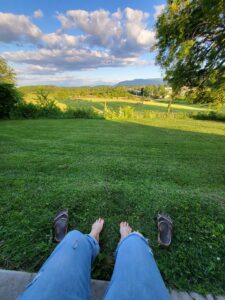A listener asks, “can you discuss exercise and its role in hormone balance and importance as we age?”
Let me start by saying that, in addition to all the other benefits, physical activity is associated with a 25 % reduction in the average risk of breast cancer among women, and this protective effect appears to be independent of menopausal status.
In previous episodes we have talked about some of the hormone imbalance issues that can occur in women. Estrogen dominance can occur at any age but is most commonly seen in peri-menopausal and menopausal women. As a reminder, estrogen dominance is an imbalance of estrogen and progesterone, meaning estrogen is very high and progesterone is too low. This can cause a host of symptoms including fatigue, weight gain, foggy thinking, low sex drive, heavy periods, increased cramping with periods, breast tenderness, hot flashes, night sweats and increased PMS symptoms.
Another hormone imbalance problem called Polycystic Ovarian Syndrome, PCOS, can occur in PREmenopausal women. This hormonal problem causes high levels of testosterone which can lead to several symptoms including acne, scalp hair loss, hirsutism (or increased facial and body hair), weight gain and irregular periods. PCOS can also contribute to insulin resistance in addition to high insulin and blood sugar levels.
In a 2015 meta-analysis of randomized controlled trials, the effect of physical activity on circulatory female hormones was evaluated.
The women included in the study were all cancer free and the women were of all different ages and weights. Some of the women had PCOS, Polycystic Ovarian Syndrome. Different types and different intensity levels of exercise were included.
Regular exercise of any intensity level or duration lowered high estrogen levels and high testosterone levels. So, women who have either Estrogen Dominance or PCOS can improve these hormonal imbalances with regular exercise.
Of course, additional benefits of regular exercise include improved mood, improved energy, better sleep and improved balance and mobility. So, if you have not found an exercise regimen that you can enjoy on some level and maintain on a regular basis, I urge you to explore some options so you CAN incorporate exercise into you life. If you are having difficulty finding a way to exercise while we are staying at home during the time of COVID 19, I recommend that you explore the Peloton app, which at the time of the initial airing of this episode on May 30, 2020, are offering a 30 day free trial. The app includes classes for strength training, yoga, mediation, cardio, stretching, bootcamp, walking, running and cycling. The classes are offered at beginner, intermediate and advanced levels. So you can check out all different types of classes at a level of intensity that works for you. https://www.onepeloton.com/app
While we are have touched on the subject of estrogen dominance, another listener, Angela states she has been on Premarin 0.625 mg since her hysterectomy in her 20s. She is now 45 years old and has weight gain, low libido and fatigue.
Angela, I am going to assume that since you were prescribed Premarin after your hysterectomy in your 20s that you had your uterus AND your ovaries removed. First of all, I am sorry that you had to have that surgery at such a young age. When the ovaries are removed from a woman who is still having periods it throws her immediately into menopause. Because of this, when someone has the ovaries removed, an estrogen replacement is prescribed right away.
We have discussed this previously, but most of the time, when a woman has a hysterectomy, progesterone is not prescribed. Progesterone thins the lining of the uterus and estrogen thickens the lining of the uterus. So, when HRT is prescribed for a woman who still HAS a uterus, progesterone is prescribed along with the estrogen to make sure that the lining isn’t overstimulated which can lead to endometrial cancer, or cancer of the lining of the uterus.
For women who HAVE had the uterus removed, there is no longer concern about the thickness of the uterine lining, so those women are NOT given progesterone. The problem is that progesterone has many other benefits besides keeping the lining thin. It is our sleep promoting and mood stabilizing hormone. I helps with sex drive and slows growth of the breast cells. Unfortunately, women who have had a hysterectomy don’t receive the hormone that really balances estrogen.
So, Angela, what you have is estrogen dominance. You have lots of estrogen and NO progesterone. Additionally, Premarin is a conjugated estrogen, meaning it contains several different types of estrogen. It is a mixture of 30-plus substances derived from the urine of pregnant mares. Estradiol — the dominant sex-steroid hormone in woman — accounts for about 17 percent of Premarin’s total content.
Additionally, there is a difference between taking bio-identical estradiol and Premarin. A new study let by Stanford University School of Medicine researchers found that, when ESTRADIOL was started soon after menopause, it prevented degeneration in key brain regions of women who were at high risk for developing dementia. They also found that Premarin, which contains only a small amount of estradiol was far less brain protective and actually accelerated some of these brain regions’ decline.
For my patients with estrogen dominance, I use bio-identical estrogens and balance it with progesterone, even if they have had a hysterectomy. Also, I always use bio-identical progesterone versus synthetic progestin which does not provide the same benefits as progesterone. The Stanford study also found that when progestin (which again, is not the same as progesterone) was added to either Premarin or estradiol it deleted any brain benefits provided by estradiol and worsened the decline seen with Premarin.
So, the take home message is that exercising regularly and having a balanced regimen of estrogen and progesterone can address the symptoms of estrogen dominance.
Thanks again to our listeners for the excellent questions!




